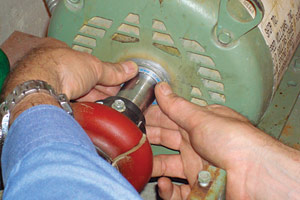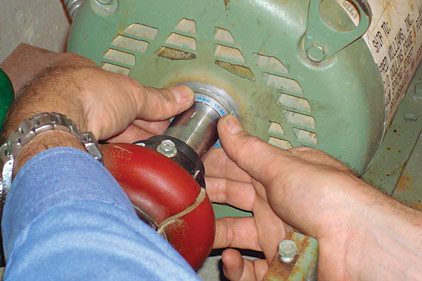
|
| To enhance conductivity, the motor shaft adjacent to the end bracket was coated with AEGIS colloidal silver. |
A preventive maintenance program at a New England Ivy League university demonstrates how the push for more sustainable green-building management has led to growing awareness of a chronic, widespread problem with HVAC motors — electrical bearing damage.
Variable-frequency drives (VFDs), also known as inverters, are widely used because they save energy, especially in applications with variable-torque loads. It’s widely recognized that because many centrifugal fans and pumps run continuously, their motors use less power if the speed is controlled by VFDs rather than a damper for flow control. But if downtime occurs, savings from efficiency increases vanish. Shaft currents induced by VFDs can wreak havoc with bearings, dramatically shortening motor life and causing costly repairs. To mitigate these currents and realize the full potential of VFDs, a reliable method of shaft grounding is essential.
Campus Sustainability
The university’s maintenance department pursued a campus-wide push for sustainability with the renovation of its own headquarters. When completed in 2006, the complex received a LEED Platinum rating, serving as a model for the more than 300 buildings serviced by its staff.
Among the department’s efforts to foster sustainability is a testing and retrofitting program for VFD-controlled HVAC motors. Technicians use portable probes and oscilloscopes to test fan and pump motors for harmful shaft voltages. Ironically, some products designed to protect bearings, such as conventional grounding brushes, require extensive maintenance themselves. Others, such as bearing isolation, can shift electrical damage to connected equipment. So, when harmful discharge levels are detected, the maintenance department usually recommends the installation of a bearing-protection device that bleeds off the damaging currents — the AEGIS™ SGR Bearing Protection Ring. A shaft grounding ring, it safely redirects VFD-induced shaft voltages by providing a very low-impedance path from shaft to frame, bypassing the motor bearings entirely.
Manufactured and sold by Electro Static Technology, the grounding ring is available in two versions — solid or split. Designed for installation with either brackets or conductive epoxy, the split ring used by the university speeds field installations because it can be installed without uncoupling the motor from attached equipment.
Fast, Easy, Long-Lasting
To demonstrate its effectiveness, the AEGIS split ring was installed on two VFD-controlled HVAC motors in the basement of the maintenance headquarters, which is cooled in the summer by ground-source heat pumps. Motor one powers a chilled-water pump. Motor two runs an air-supply fan. Both are Baldor 7.5-hp motors (NEMA frame size 213T).
When a voltage probe was held against the shaft of Motor one, the oscilloscope indicated peak-to-peak discharges of 61 V with rapid voltage collapses at the trailing edge of the waveform — typical of the electrical discharges that damage bearings.
After the readings, the shaft was cleaned with fine-grit sandpaper and wiped with an alcohol-dampened rag. Paint was removed from the motor end bracket with a Dremel rotary tool, exposing enough bare metal to mount the AEGIS split ring. The two-part conductive epoxy (included in the manufacturer’s kit) was mixed and applied to the back of the ring. To enhance conductivity, the motor shaft adjacent to the end bracket was coated with AEGIS colloidal silver. Next, the ring was opened, centered around the shaft, taped closed, and pushed against the end bracket. The entire installation took about 10 minutes.
Approximately an hour after installation, the epoxy had cured sufficiently to allow testing of the motor again with the oscilloscope and probe. This time, the oscilloscope discharge plot was essentially a flat line, indicating that shaft voltage discharges were being diverted by the AEGIS ring to ground.
On Motor two, pre-installation peak-to-peak shaft discharges measured 50.8 V. The shaft was prepared, but because it was difficult to reach, and only a couple of inches of it between the end bell and a sheave were exposed, the versatility of the AEGIS split ring and its ease of installation using conductive epoxy were even more apparent.
A hand-held heater was used to speed the epoxy’s cure, and about half an hour after installation the shaft voltage was measured again. This time, the reading was only 380 mV (peak-to-peak).
Sustainable Technology
For years, VFD-induced bearing failure was often misdiagnosed, until repair shops and testing consultants proved that the high-peak voltages, fast voltage rise times, and non-sinusoidal shaft currents associated with typical pulse-width-modulated VFDs lead to the cumulative erosion of ball bearings and race walls.
For motors already in service, the ring can be retrofitted on any National Electrical Manufacturers Association (NEMA) or International Electrotechnical Commission (IEC) motor regardless of shaft size, horsepower, or end-bell protrusion. Key to the ring’s success is conductive microfibers that line the entire inner circumference of the ring in two rows, completely surrounding the motor shaft. Once installed, the ring requires no maintenance and lasts for the life of the motor, regardless of rpm.
New from Baldor
Baldor Electric Co. recently introduced its Super-E® NEMA Premium® line of inverter-ready, 1-50 hp, general-purpose motors with AEGIS grounding rings factory installed inside the motor housing. Customers can choose a totally enclosed fan-cooled (TEFC) or open drip-proof (ODP) configuration.
Operations and maintenance costs can account for 60-80 percent of a building’s life-cycle costs. When equipment does not have to be repaired or replaced as often, that percentage drops significantly. The university’s maintenance department is aggressively promoting the AEGIS SGR Bearing Protection Ring as a way of safeguarding energy savings and realizing the full cost-saving potential and ROI of VFDs.
For more information, visit www.est-aegis.com.
Publication date: 4/15/2013


Report Abusive Comment